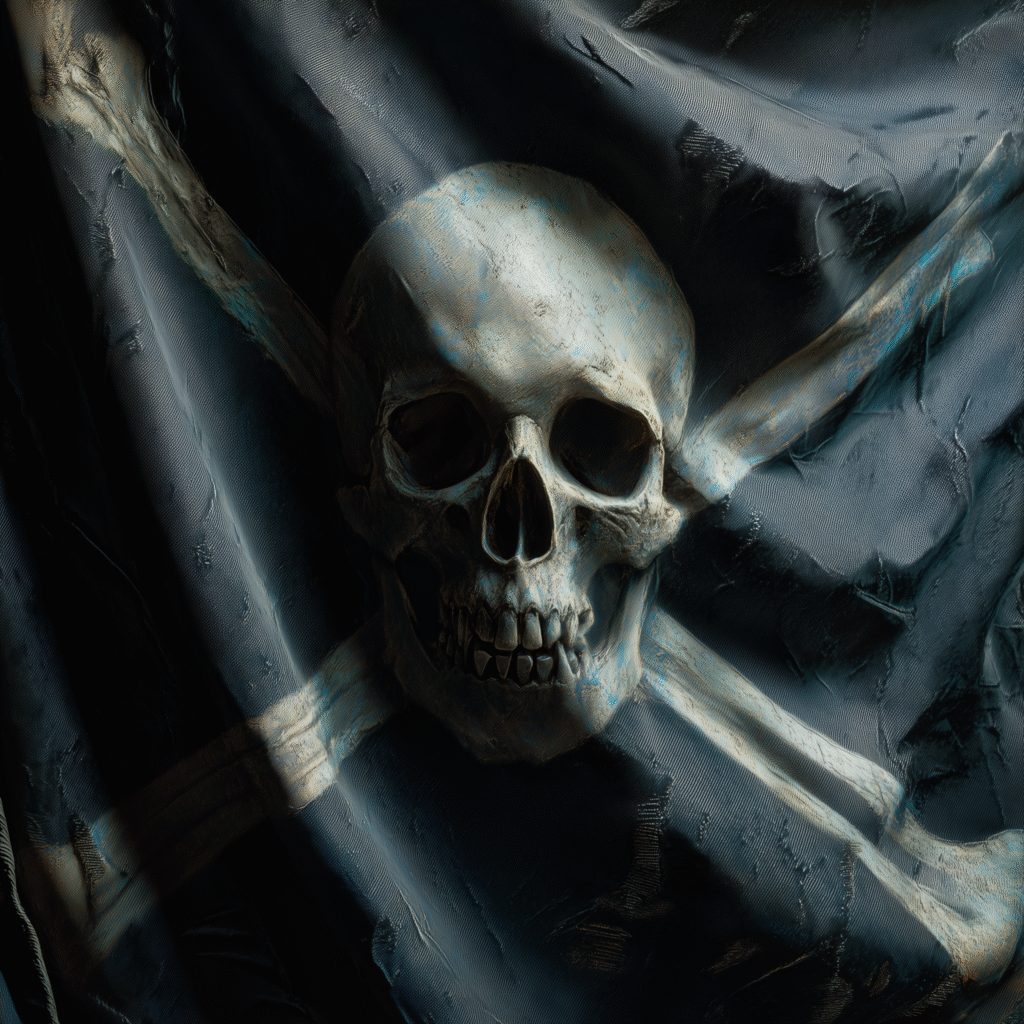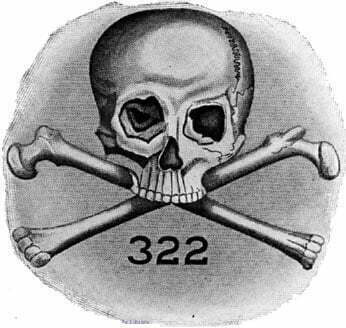Skull and Bones, “The Bone Conclave”
“Within Yale’s darkest tomb, the secret society of the Skull and Bones weaves power, ritual, and shadowy pacts into an eldritch conspiracy of the elite.”

- Name – Skull and Bones
- Symbol / Emblem – A grinning human skull over crossed femurs; accompanied by the number 322 and black-and-white banners that seem to shimmer with an almost unnatural pulse.
- Motto or Slogan – “Through the Bone, the Hidden Speaks.”
- Type – Secret society; elite collegiate order blending scholarship, ritual, and clandestine influence.
- General Alignment – Chaotic Evil / Malignant: members pursue knowledge and influence that imperils sanity and bends human affairs toward inscrutable ends.
- Purpose / Function – Outwardly a fellowship of Yale seniors promoting leadership and camaraderie; secretly a society that safeguards forbidden knowledge, collects symbolic relics, and cultivates influence over mortal institutions.
- Founding Date / Origin – Emerged centuries prior to the modern era, rooted in scholarly circles and hidden chambers where young visionaries first sought the unseen patterns of the cosmos.
- Founders – A circle of Yale scholars and aspirants whose names are lost to secrecy, said to have vanished after codifying the earliest rituals and symbols.
- Beliefs & Core Values – Bone is vessel and record; death is a threshold to hidden insight; knowledge outweighs morality; the universe whispers truths incomprehensible to the ordinary mind; human life is fragile and expendable when weighed against understanding.
- Public Reputation – Respected among Yale elites and influential circles; feared by the superstitious and whispered of as wielders of hidden power beyond human reckoning.
- Hidden Agenda (if any) – To acquire and protect esoteric knowledge, relics, and symbols; cultivate influence over leaders and institutions; preserve access to truths and forces mortals are ill-prepared to face.
- Leadership & Hierarchy – Governed by a Triarchic council in bone masks; beneath them a hierarchy of full initiates, apprentices, and peripheral operatives; authority is maintained through ritual, secrecy, and subtle manipulation.
- Number of Members – Traditionally limited to 15 Yale seniors annually; a wider network of alumni retains enduring influence.
- Key Figures – Historically anonymous; notable alumni include influential politicians, financiers, and leaders whose precise role in the society remains secret.
- Recruitment & Membership – Candidates are chosen during “Tap Day” for ambition, intellect, and discretion; recruitment is highly secretive and selective.
- Initiation Rites or Requirements – Conducted within the Tomb; rituals involve oaths, symbolic interaction with skulls and bones, and exposure to esoteric texts and patterns; experiences often leave lasting psychological transformation.
- Rules / Code of Conduct – Absolute secrecy; unwavering loyalty; preservation of symbols and knowledge; adherence to tradition; careful cultivation of influence in public life.
- Headquarters / Base of Operations – The Tomb: a windowless sandstone building on Yale’s campus; interior designed to awe, disorient, and impress secrecy upon initiates.
- Territory / Sphere of Influence – Yale University and alumni networks; influence extends into politics, finance, and global affairs through carefully positioned members.
- Allies – Select scholars, artisans, noble families, and other secretive societies aligned with their pursuit of influence or knowledge.
- Rivals / Enemies – Competing societies, institutions seeking to limit their influence, or inquisitorial bodies; rumored rivalries with other occult groups.
- Known Operations or Projects – Collection and safeguarding of symbolic artifacts; mentorship of members into positions of power; study of myths and esoteric texts for hidden patterns.
- Funding / Resources – Alumni endowments, private patronage, control of archives, and selective trade of rare texts or artifacts.
- Affiliated Organizations – Yale alumni networks, other elite collegiate societies, and peripheral academic or artisan guilds.
- Symbols in Use – Tattoos of crossed femurs or coded runes; black-and-white banners; carved motifs in architecture; ceremonial use of bone and obsidian objects.
- Attitude Toward Outsiders – Highly secretive; outsiders are either manipulated, ignored, or eliminated from knowledge of the society’s deeper purpose.
- Customs & Rituals – Annual initiation ceremonies; midnight assemblies; oaths sworn over symbolic bones; recitation of coded texts; study and use of esoteric patterns.
- Language / Ciphers Used – Arcane sigils, coded scripts, ritualistic phrases intelligible only to initiates; some speech designed to convey visions rather than conventional meaning.
- Notable History / Key Events – Rumored interventions in politics, finance, and academia; preservation of symbolic relics during pivotal historical events; long subject of conspiracy theories about global influence.
- Human/Non-Human Members – Exclusively human, though legends and rumor treat them as conduits for forces and knowledge beyond ordinary comprehension.

Whispers carried on sea-winds and market-songs speak of the brotherhood called the Skull and Bones. Their device is a visage of death grinning eternal, its gaze crossed by the long relics of the grave, borne upon banners black as moonless void. To the world they feign themselves curators of ancient law, preservers of noble custom, counselors to princes and merchants alike. Yet their true gatherings take place in windowless halls where light falters, and there they commune not with man nor saint, but with the nameless hungers that drift beyond the stars and sleep beneath the earth.
The brethren proclaim that bone is a vessel, a script older than speech, in which the universe itself inscribes its hidden truths. They whisper that the skull, emptied of mortal thought, becomes a gate through which alien voices murmur. To behold such relics is to unshackle the mind from its fragile moorings and drift toward vistas unmarked on any chart. Among nobles, their counsel is sought with fear; among scholars, their name is traded like contraband; and the common folk murmur of them as shadow-walkers who emerge from storms or graveyards with eyes reflecting stars that no sailor has ever charted.
They do not scorn the myths of fisherfolk or the sagas of shepherds; rather, they harvest them as one plucks strange fruit. The keening banshee, the drowned empires glimpsed beneath restless seas, the giants turned to stone that line forgotten valleys—these are not to them mere fables, but fragments of a greater tapestry. In hidden vaults they inscribe what they have gleaned in inks of salt and ash, binding their tomes in hides that ripple like water under moonlight. Their dominion is not of borders and crowns, but of thresholds—where dreams blur with waking and where silence deepens into a voice.
Initiates are chosen from among the restless and the bold, those whose eyes have already begun to wander beyond the horizon of reason. The trial is spoken of only in fragments: a night sealed in stone, a draught drawn from vessels that taste of tides more ancient than oceans, and the moment when the world is revealed not as it is, but as it truly seethes. Few emerge, and those who do wear pallor like a shroud, their words always half-listening to some other choir.
Their hierarchy is a triad enthroned in bone, each face veiled, each voice an echo not entirely their own. Chroniclers mutter that at the fall of a great city, when fire consumed its walls and towers crumbled into dust, it was these brethren who scoured the ruins—not for treasure, nor for relics of kings, but for stones that pulsed faintly with a rhythm like a heartbeat, and for scrolls written in letters no tongue of man can form.
Thus the Skull and Bones endures, less a brotherhood than a fissure in the fabric of the world, from which seep whispers that were never meant for human ears.
The Skull and Bones Plan
The Skull and Bones plan is not merely a scheme for influence—it is a multigenerational covenant with powers that should not exist. The society’s leaders act as intermediaries for the Great Old Ones, channeling their will through ritual, relics, and human agents. While outsiders see a collegiate order, insiders follow a cosmic agenda: to prepare the world for the return or awakening of alien intelligences, subtly bending mortal events to align with unfathomable geometries of fate.
Core Objectives
- Recruitment of Sensitive Minds
- Each year, 15 carefully chosen initiates are brought into the fold; only those with latent psychic sensitivity, ambition, or intellectual curiosity survive the rituals.
- Initiates are conditioned to perceive the patterns of the cosmos, making them ideal conduits for eldritch influence.
- Acquisition of Forbidden Relics
- Objects once belonging to vanished civilizations or touched by alien forces are collected and stored in the Tomb or secret vaults.
- Relics may radiate madness or visions, offering power in exchange for obedience to alien will.
- Manipulation of Mortal Events
- Influence politics, trade, and scholarship to align human society with cosmic cycles, preparing the world for Great Old Ones’ resurgence.
- Rituals, symbols, and subtle manipulation ensure events unfold according to alien geometries and omens rather than human reason.
- Ritual Communion and Knowledge Expansion
- Secret ceremonies involve summoning or contacting Great Old Ones through dreams, visions, or physical portals.
- Eldritch knowledge gained is encoded in cryptic sigils, texts, and bone artifacts—decipherable only by initiates.
- Containment and Exploitation of Dangerous Entities
- Suppress rival cults or rogue mages who might awaken the Old Ones prematurely or disrupt society’s plan.
- Protect humanity from forces too powerful to confront directly, while selectively using them as instruments of influence.
Long-Term Vision
The Skull and Bones plan is cosmic in scope, spanning centuries or even millennia. Members are both agents and sacrifices: they live and die to maintain the web of influence, slowly bending human history to accommodate alien designs. Each relic, ritual, and initiated mind is a node in a larger pattern, invisible to ordinary mortals. When the Great Old Ones awaken, the society hopes to guide their arrival, survive the chaos, and claim positions of power in the new order.
Membership of Skull and Bones
Low-Ranking Positions: Initiates & Apprentices of the The Skull and Bones
- Title: Bone Seeker
- Role & Responsibilities: Newly tapped members who undergo orientation and early rituals. They are tasked with learning the cryptic codes, symbols, and history of the society. They maintain the Tomb, assist in ritual preparation, and gather hidden knowledge from libraries or secret archives.
- Mystical/Ideological Flavor: Bone Seekers are exposed to visions of alien geometries and whispered truths through symbolic rites; their dreams may carry subtle messages from the society’s “hidden patrons.”
- Approx. Number: ~15 per year (aligns with real-world Tap Day intake)
- TTRPG Mechanics Suggestion: Consider giving them a “Haunted Insight” trait—minor glimpses of alien truths that grant advantage on arcana, history, or investigation checks, but occasionally impose minor madness effects.
- Title: Tomb Ward
- Role & Responsibilities: Custodians of the Tomb itself, responsible for guarding ritual chambers, relics, and ceremonial objects. They ensure outsiders are kept away and that all ceremonies proceed without interruption.
- Mystical/Ideological Flavor: Tomb Wards are taught subtle wards, sigils, and protective rituals; some are entrusted to read or interpret cryptic patterns that appear on walls or relics.
- Approx. Number: ~5–7 per Tomb (dependent on the size of the hidden sanctum)
- TTRPG Mechanics Suggestion: Tomb Wards might be ritual initiates with basic protective spells, minor invocations, or knowledge of sigils that impede intruders.
Mid-Ranking Positions: Full Members & Operatives of the The Skull and Bones
- Title: Bonesman / Boneswoman
- Role & Responsibilities: Core members who have survived initiation and gained full access to the society’s texts, relics, and rituals. They mentor low-ranking members, conduct advanced rituals, and manage influence in external networks (e.g., courts, guilds, or scholarly societies).
- Mystical/Ideological Flavor: Bonesmen act as conduits for hidden knowledge. They can “read the bone” for omens, interpret symbols in dreams, and subtly manipulate outcomes in the mortal world to match cosmic patterns.
- Approx. Number: ~30–50 active members at any given time
- TTRPG Mechanics Suggestion: Full members may gain Occult Lore, minor telepathy, or insight into future events; they also have limited “Influence Points” for social manipulation or coercion.
- Title: Sigil Keeper
- Role & Responsibilities: Specialists entrusted with maintaining the society’s cryptic ciphers, ritual inscriptions, and magical texts. They are often called to verify or interpret symbols during rites or secret operations.
- Mystical/Ideological Flavor: Sigil Keepers are deeply attuned to the eldritch geometry and alien patterns of the society’s lore; they may perceive changes in reality before others.
- Approx. Number: 5–10 within the mid-tier
- TTRPG Mechanics Suggestion: Sigil Keepers could provide ritual bonuses, detect magical auras, or assist in deciphering alien texts, granting advantage to arcana or investigation checks.
High-Ranking Positions: Leaders & Triarchs of the The Skull and Bones
- Title: Triarch of the Bone
- Role & Responsibilities: The supreme leaders of the society, forming a council that directs operations, oversees all rituals, and interprets cosmic truths. They decide on recruitment, deployment of agents, and the protection or exploitation of forbidden knowledge.
- Mystical/Ideological Flavor: Triarchs are said to “see the pattern beneath the stars” and may communicate directly with alien intelligences. They embody the society’s ideology, blending mysticism, secrecy, and worldly influence.
- Approx. Number: 3
- TTRPG Mechanics Suggestion: Triarchs could have high-level divination, minor reality-warping powers, and the ability to invoke temporary madness or awe in mortals who witness their rituals.
- Title: Master of the Tomb
- Role & Responsibilities: The chief custodian and ritual director of the Tomb itself; ensures that sacred relics, ceremonies, and initiations proceed flawlessly. Reports directly to the Triarchs and maintains secrecy among all ranks.
- Mystical/Ideological Flavor: The Master can perceive disturbances in the alien patterns within the Tomb and manipulate spatial or temporal anomalies within the chambers.
- Approx. Number: 1 per Tomb
- TTRPG Mechanics Suggestion: The Master could grant ritual bonuses, impose penalties on intruders, and have access to unique eldritch effects tied to the Tomb’s architecture.

 Buy me a coffee
Buy me a coffee